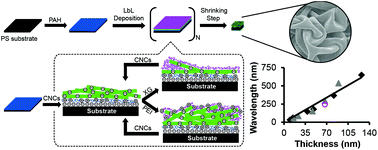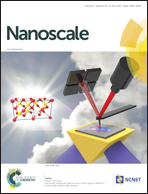Beyond buckling: humidity-independent measurement of the mechanical properties of green nanobiocomposite films†
Abstract
Precise knowledge of the mechanical properties of emerging nanomaterials and nanocomposites is crucial to match their performance with suitable applications. While methods to characterize mechanical properties exist, they are limited by instrument sensitivity and sample requirements. For bio-based nanomaterials this challenge is exacerbated by the extreme dependence of mechanical properties on humidity. This work presents an alternative approach, based on polymer shrinking-induced wrinkling mechanics, to determine the elastic modulus of nanobiocomposite films in a humidity-independent manner. Layer-by-layer (LbL) films containing cellulose nanocrystals (CNCs) and water-soluble polymers were deposited onto pre-stressed polystyrene substrates followed by thermal shrinking, which wrinkled the films to give them characteristic topographies. Three deposition parameters were varied during LbL assembly: (1) polymer type (xyloglucan – XG, or polyethyleneimine – PEI); (2) polymer concentration (0.1 or 1 wt%); and (3) number of deposition cycles, resulting in 10–600 nm thick nanobiocomposite films with tuneable compositions. Fast Fourier transform analysis on electron microscopy images of the wrinkled films was used to calculate humidity-independent moduli of 70 ± 2 GPa for CNC-XG0.1, 72 ± 2 GPa for CNC-PEI0.1, and 32.2 ± 0.8 GPa for CNC-PEI1.0 films. This structuring method is straightforward and amenable to a wide range of supported thin films.



 Please wait while we load your content...
Please wait while we load your content...